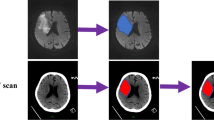Summary
Cerebral ischemic lesions may present two different types from the pathologic point of view. The classic cerebral infarct produced by a vascular occlusive lesion with formation of a zone of softening or encephalomalacia and the so-called Incomplete infarct caused by hypoxic damage of the brain without vascular occlusion, and their course, commonly may be stabilized and evolve clinically and angiographically as a neoplastic tumour. The present paper attempts to establish a pathologic and angiographic correlation of this way of cerebral ischemic lesion known as Incomplete infarct.
Résumé
Du point de vue pathologique, on peut distinguer deux groupes de lésions ischémiques cérébrales.-1. L'infarctus cérébral classique produit par une lésion vasculaire occlusive avec formation d'une zone de ramollissement ou encéphalo-malacie.-2. L'infarctus incomplet causé par une lésion hypoxique du cerveau sans occlusion vasculaire qui peut se stabiliser ou évoluer cliniquement ou angiographiquement comme une tumeur néoplasique. Ce travail tente d'établir une corrélation pathologique angiographique de cette lésion ischémique cérébrale appelée infarctus incomplet.
Zusammenfassung
Vom pathologisch-anatomischen Gesichtspunkt gibt es zwei verschiedene. Typen einer cerebralen ischämischen Lesion. Beim klassischen Infarkt handelt es sich um einen Gefäßverschluß mit den Folgen einer Encephalomalazie. Der sog. inkomplette Infarkt wird durch eine Hypoxämie hervorgerufen. Ein Gefäßverschluß besteht hier nicht.
Similar content being viewed by others
References
Cronqvist, S.: Regional cerebral blood flow and angiography in apoplexy. Acta radiol. 7, 521 (1968).
—: Transitory hyperaemia in focal cerebral ischemic lesions. IIIrd. Int. Symp. on cerebral circulation. Salzburg 1966. Springfield, Illinois: Charles C. Thomas, Publ. 1969.
—, Laroche, F.: Transitory hyperaemia in focal cerebral vascular lesions studied by angiography and regional cerebral blood flow measurements. Brit. J. Radiol. 40, 270 (1967).
Farmer, T.W., Swanton, M.C.: Cerebral thrombosis with ventricular displacement. Neurology 5, 587 (1955).
Ferris, E.J.: Early venous filling in cranial angiography. Radiology 90, 553 (1968).
— Shapiro, J.H., Simeone, F.A.: Arteriovenous shunting in cerebrovascular occlusive disease. Amer. J. Roentgenol. 98, 631 (1966)
Høedt-Rasmusen, K.: Regional cerebral blood flow the intraarterial injection method. Copenhagen: Munksgaard 1967
Huber, P.: Die hyperämische Phase beim zerebralen Infarkt. Praxis 57, 9 (1968).
Ingvard, D.H.: The pathophysiology of occlusive cerebrovascular disorders related to neuroradiological findings EEG and measurements of regional cerebral blood flow. Acta neurol. Scand. 43, 93 (1967).
King, A.B.: Massive cerebral infarction producing ventriculographic changes suggesting a brain tumor. J. Neurosurg. 8, 536 (1951).
Lanner, L.O., Rosengren, K.: Angiographic diagnosis or intracerebral vascular occlusions. Acta radiol. 2, 129 (1964).
Leeds, N.E., Taveras, J.M.: Dynamic factors in diagnosis of supratentorial brain tumors by cerebral angiography. Philadelphia, London, Toronto: W.B. Saunders Co 1969.
Meyer, A.: In Greenfield's Neuropathology, p. 239. London: Edward Arnold Publ. Ltd. 1963.
Pitts, F.W., Haskin, M.E., Riggs, H.E., Groff, R.A.: “Tumor Stain” in cerebrovascular disease. J. Neurosurg. 21, 298 (1964).
Pons-Tortella, E.: Lesiones cerebrales por isquemia. Minerva cardioangiológica Europea. IXème. Année 273 (1961).
—, Llovet Tapies, J.: Tumoraciones no neoplàsicas y seudotumores cerebrales. Med. Clínica, XXXVIII, 3, 24 (1962).
Scholz, W.: Die nicht zur Erweichung führenden unvollständigen Gewerbsnekrosen, in Handb. Spec. Path. Anat Hist vol. XIII, ed. Scholz, W.I.B., p. 1284.
Smiley, G.L.: Occlusive cerebrovascular disease simulating brain tumor. Angiographic differentation. Arch. Neurol. Psychiat. Chicago 67, 633 (1952).
Taveras, J.M.: Angiographic observations in occlusive cerebrovascular disease. Neurology 11, 86 (1961).
—, Gilson, J.M., Davis, D.O., Kilgore, B., Rumbaugh, C.L.: Angiography in cerebral infarction. Radiology 93, 549 (1969).
Wood, E.H., Farmer, T.W.: Cerebral infarction simulating brain tumors. Radiology 69, 693 (1957).
Author information
Authors and Affiliations
Rights and permissions
About this article
Cite this article
Solé-Llenas, J., Pons-Tortella, E. Correlation between pathologic and angiographic findings in so-called “Incomplete cerebral infarct”. Neuroradiology 4, 108–113 (1972). https://doi.org/10.1007/BF00344438
Issue Date:
DOI: https://doi.org/10.1007/BF00344438




